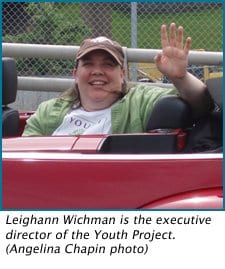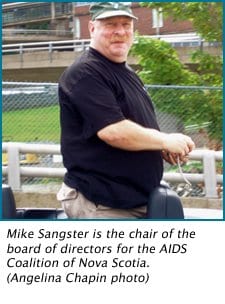Every year, the Halifax Pride committee chooses one or two grand marshals to ride in cars at the front of the parade. The honor is bestowed on those who’ve made significant contributions to the gay community and this year is no exception. But Leighann Wichman and Mike Sangster have something else in common: both hesitantly accepted the title, blushing at the prospect of being in the spotlight.
***
LEIGHANN WICHMAN
Leighann Wichman plays the drums loud. Walking into the Youth Project house it’s the first thing I hear. Upstairs in her office, Leighann shrinks into her chair, more comfortable behind her drum than telling her life story.
“I don’t like being the centre of attention,” she says. “Everybody knows that around here and they’ve been making fun of me since I found out.”
Three weeks ago the executive director of the Youth Project found out she was chosen as a grand marshal in the Pride parade. When she hesitated to accept, the youth she works with threatened to picket the Youth Project in protest.
For the past 15 years, Leighann’s been involved with the organization that provides queer youth under 25 with information, counselling and support. She puts in over 40 hours a week to organize workshops, set up events, and travel to communities in Nova Scotia interested in the cause.
Back in 1993 when she was 21, Leighann attended a talk on homophobia as part of Pride Week. She was taking a sociology degree at Dalhousie and hadn’t come out to her friends or family. Maura Donovan, the founder of the Youth Project, was giving out flyers advertising the program and Leighann decided to show up.
“Being at the Youth Project was the first time I got to talk about being gay,” she says. “I went through all of junior high with no support or info and I was afraid to say anything to my friends and parents.”
The Youth Project, which started as a six-month field placement for Maura’s social work degree, turned into a permanent organization. The first members, who were a group of about 15 people mostly in their early 20s, wanted to keep it going. Among them was Leighann, who came out to her parents six months after joining.
She volunteered at the project while finishing her undergrad degree, which she switched to health education to study discrimination and its effects. By the time she graduated in 1998, the not-for-profit organization received funding from the federal government and Leighann applied for a full-time paid position.
Leighann proudly shows me the coloured walls, decorated with the youth’s art projects. The Gender Scene Investigation (GSI) wall has papers with fingerprints beside different labels the youth identify with. The Transmosaic wall has ceramic tiles dedicated to influential transgendered people.
“The Youth Project is important to me because it would’ve made a big difference in my life from 14 to 21,” she says, adding the average age at the project is 16. “I would’ve had more confidence and come out earlier.”
Anywhere from 50 to 60 youth regularly hang out at the house in the north end of Halifax and show up to events like coffee houses and movie nights to socialize.
“This is our media wall,” she says, pointing proudly to a yellow wall with a series of newspaper clippings. “Here’s one after we first started in 1993,” she says, more meekly. And there she is: a younger, bashful-looking Leighann peeking out behind three others.
***
MIKE SANGSTER
Mike Sangster remembers marching in the first Halifax Pride parade with a paper bag on his head. In 1988 it was still illegal to be gay in Nova Scotia, and 10 or 15 of the 75 marchers covered their faces.
“We didn’t know what could happen,” says Sangster, remembering the threat of losing his job or being evicted from his apartment. “There was just a determination to get together and march.”
Sangster sits in front of me 20 years later fidgeting. “It feels weird,” he says of being chosen as grand marshal for the Pride parade. “I’m a shy person. I’ve never been out there waving my hands.”
Sangster, 57, looks down and plays with his fingers when talking about his involvement in the gay community. “I never chose leadership positions,” he says. “I was always doing something in the background.”
The Halifax-native was treasurer for the Gay and Lesbian Alliance (GALA) in the early ’80s. Outraged by events such as the Stonewall riots in New York in the late ’60s and raids of Toronto bathhouses in the early ’80s, GALA members decided to organize the first Halifax march.
“We needed to speak for the gay and lesbian population in Halifax,” he says. “So we started protesting.”
After finishing his arts degree at Dalhousie and working a series of odd jobs, Sangster worked for 20 years as a warehouse supervisor for Westinghouse Electric Company in Halifax. Two years ago he went on disability-leave, after having a heart attack and triple bypass surgery.
Sangster is now the chair of board of directors for the AIDS Coalition of Nova Scotia (ACNS), a position he never anticipated taking.
“I did it because I felt no one else would,” he says. “People are dependent on these organizations.”
In the early 80s, when the AIDS epidemic broke out, he got involved with ACNS because many of his friends were dying of the disease.
“AIDS is quite important to me,” says Sangster, who was diagnosed as HIV-positive 10 years ago. “It’s important that people with HIV/AIDS have a voice in the organization and aren’t only being represented by a government agency.”
He took on the position of board chair in 2004, volunteering full-time and making decisions about the projects, finances, and general direction of the ACNS. In addition, he’s the Nova Scotia representative on the Canadian Treatment Action Council (CTAC), a member of Canadian AIDS Treatment Information Organization (CATIE) and the Canadian Aids Society (CAS).
As a volunteer, Sangster believes in the work he’s doing. “I’m doing something important that might make a difference,” he says. “As a person with AIDS and a gay man I can have my voice heard in a national setting.”
As the grand marshal of the Pride parade, he’s less sure of his role. “There’s so many others who could’ve been chosen,” he says. “The main thing is I’m here to represent activists who aren’t being recognized for their work and those who have died.”


 Why you can trust Xtra
Why you can trust Xtra


